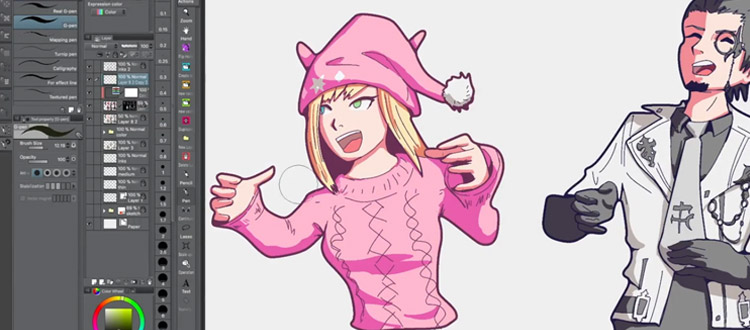Best Free Clip Studio Paint Tutorials
Clip Studio Paint(previously Manga Studio) is a powerful piece of software for digital artists and comic book creators.
The basic version is super cheap and it’s one of the most popular tools for manga creators in Japan.
But picking up new software can always be a challenge. This goes double for digital painting software that you’re trying to learn from scratch.
If you’ve used digital drawing/painting software before then you’ll find the learning curve is minimal. Total beginners may need a little more help but that’s why we’re here!
If you’re looking to improve your Clip Studio Paint skills then check out these awesome tutorials on a variety of topics, all 100% free.
Clip Studio Paint Basics
This comprehensive tutorial is 35 minutes long and will take you through the basic mechanics of the program.
It’s perfect for artists who know some basics of digital painting and are eager to dive into more details with CSP.
The tutorial starts off with the basic interface, canvas settings, and where to customize brush options.
Next the artist sketches a simple dinosaur head from start to finish highlighting the smooth feel of the pencil tool and razor-sharp pen tool.
He dives deeper into how colors can be naturally blended with the blend tool, showing multiple examples with many different types of brushes and blend patterns. Finally you’ll learn how to use different layers(ink and flat) to manipulate your drawings without merging layers.
More CSP Basics
If you are new to digital painting this tutorial is what you need.
In under 20 minutes all the essential tools are covered along with a basic “how to” explanation of how digital drawing/painting works.
To get you acquainted with the inner workings of Clip Studio Paint the artist goes over the interface showing you where everything is and how to use the selection and shape tools.
He also demonstrates the powerful default brushes, how to customize them to your needs, and what sort of textures they can create.
After an overview of the lasso tool you’ll finish up by learning how to use Clip Studio’s 3D template characters to draw awesome characters quickly.
How To Draw Digitally
If you plan on drawing in a manga style or creating your own manga from scratch then you may need a quick tutorial to get you started.
Well look no further!
This artist keeps it need-to-know and doesn’t overwhelm you with too many small details.
Drawing a cute anime character while she explains the tools, you’ll learn how to sketch and create line art for your pieces following that classic manga style.
Top 10 Clip Studio Paint Features
There are so many programs out there and it’s easy to ask “what makes Clip Studio Paint so special?”
This tutorial answers that question with an overview of key features that this artist finds most useful.
Each section is explained in text and then demonstrated on screen.
The artist covers things like multi-layer transform, natural brush to eraser switches, and the 3D library of objects. This video spares no detail and gives you plenty of reasons why each feature is so useful.
If you weren’t really sold on Clip Studio Paint yet then I have a feeling you’ll be raring to go after this video.
How To Ink in CSP Pro
There’s a lot more to inking than just putting pen to Wacom.
Ignoring the art style itself, this tutorial is a technical review of all the inking tools available in CSP.
With a brief explanation of basic inking, the artist quickly shows that there is more to the pen tool than just clicking and dragging.
Learn how to manipulate your linework with each stroke and speed up detailed geometric work with a few tricks. The artist finishes up by inking a sketch of Batman while giving tips on style and line weight.
Draw Elegant Digital Linework
One of Clip Studio Paint’s most applauded features is the pen tool.
The programming behind the tool helps your brush strokes feel more natural and gives them a certain elegance. In this tutorial you’ll learn how to keep your lines looking fantastic.
The surface of a drawing tablet is quite slick and many beginners have trouble drawing stable lines at first.
Worse still, when you’re stuck using a mouse because your tablet won’t calibrate properly.
This artist shows you how to create precise linework for a clean, cartoony look.
Although you still need to practice manual linework on a tablet, this technique will get you started if your hand is a little wobbly or if you can’t get your settings just right.
Using Frame Folders
The primary users of Clip Studio Paint are manga and comic book artists.
There are so many tools in this program used to create borders and frames for pages of a comic book, allowing for all sorts of creative compositions.
This tutorial explains what Frame Folders are and how you use them to create frame borders and comic book panels.
The artist takes you through a system showing you little tips to make your panels stand out from the rest. There is no shortage of settings to change and you can quickly draw panels of all shapes and sizes.
Character Creation in Clip Studio Paint
Cat Farris is a well-known comic book creator with a wealth of artistic experience.
She gives you some key points to think about when designing your own character and shows you the tools needed to bring them to life.
Starting off in the inking process, she uses the default pen tool to lay down thick, bold lines to define her character.
Next she adds color going over the paint bucket tool and teaching you how to fix lineart mistakes on the fly. Using her shadow layer trick makes adding shadows a breeze, explaining why she chose a non-destructive workflow to boot.
This is merely the first step and once it’s completed she moves onto the next one: creating comic book panels and telling the story.
How To Pose 3D Models
One of the most powerful features of Clip Studio Paint is the ability to pose 3D models directly in your canvas area.
In this tutorial you’ll learn how to pose a 3D model to an existing image taking care to rotate joints and place body parts in the correct position at the right angle to create an exact match.
This is similar to using a reference image like a photo except you can design the reference however you like!
You can then save your posed model for later use or customize it even further by adding muscle or fat.
The artist explains why you should build a library of 3D models that can be used to create comics in record time. The tutorial ends off with the artist drawing their version of wonder woman entirely from a 3D model.
Toning Patterns & Exporting
Clip Studio is popular for creating manga because it has some incredible features that make previously time-consuming tasks super easy.
Adding tone patterns has always been a headache because it’s not always as simple as click & done. But this tutorial will show you how to speed up that workflow.
Starting off with some manga page line art you’ll learn how to add different tones and textures with ease.
First the paint bucket tool is explained and you’ll learn how to use the lasso tool to fill multiple areas at the same time.
Next highlights are added to emphasize the characters along with effects that sell the mood of the piece.
Near the end you’ll learn how to export your page with optimized settings for the web.
Paint Muscles in Manga Studio 5 EX
Clip Studio Paint is not just for creating sharp lineart and comic books.
You can also use the tools to create realistic artwork and mimic real-world shading. This tutorial does just that while focusing on rendering muscles.
The artist starts off by explaining the downsides of Photoshop and praising the color blending tools in Clip Studio.
With an example of what he’s creating fixed to the left of the screen, this artist starts off with a blue line sketch of a muscled arm.
Mentioning the importance of skin tone he quickly blends shadows on top of a base color drawing out the form and defining a light source.
He finishes off by showing you how to change the saturation of your colors after shading.
Turn Pictures into Manga Drawings
Manga artists are renowned for their time-saving drawing methods and they use some clever tricks to get detailed backgrounds.
By editing photos into black and white and adding halftone you can shave hours off your drawing & inking time.
With this handy video you’ll learn how to manipulate contrast levels right in CSP and turn a photo into stylized greyscale. Then, using a special filter, you can change the result into halftone mimicking the style of manga backgrounds.
How cool!
And to top it off, the artist lets you in on a few tricks to make hero objects or characters stand out even more.
Drawing Digital Comics For Beginners
This tutorial is unlike all the others in this list due to its length and structure.
Here you’re looking at a full 1-hour webinar.
It’s crammed full of tips and tricks all relayed to you by professional comic book artist Doug Hills sharing over ten years of experience.
If you don’t understand the workflow of a comic book page, this webinar will answer all your questions.
The tutorial starts with sketching atop a rough storyboard.
Doug shows you his exact process to create a finished page and how you might go about it with CSP.
After setting up the panel outlines he begins sketching the final scenes with the pen tool.
Once the pencil sketch is done he moves on to the inking process, giving you a few line work tips along the way.
Finally he discusses the benefits of using vectors and how to seamlessly integrate backgrounds with characters in your digital comics.
Manga Studio 5 EX: Story Creation (Part 1)
Most independent artists create their manga or comic one page at a time, saving it out to the appropriate format as they go.
But if you work with Clip Studio Paint EX you can create full comic books in just one file.
This tutorial goes over the various tools and functions you’ll need if you want to create more than one page at a time. This helps you work a lot faster and produce much more seamless page transitions.
The artist shows you how the layout of a traditional manga works and how to work on your pages individually.
The tools are incredibly powerful and you can even combine two pages together making it easier to draw a full double-page spread.
Animation Basics (Part 1)
Clip Studio Paint is not just for drawing; you can also use it for short snippets of animation.
Although the animation capabilities are basic, it’s a useful tool if you want to test out some aspect of your character in motion.
This tutorial starts off with a description of the animation-specific panels and layout.
The artist explains the limitations of the program and goes over the scenarios in which you’d want to rough out your animation in Clip Studio.
The video also explains specific ways you need to work to create frames on different layers.
Remember: each frame must be drawn manually. There are no in-betweens or frame holds so this is real 2D animation in action.
From Sketch To Full Color
It’s easy to look at a finished piece of art and think “I’ll never be able to do that.”
The best cure is to watch a speedpaint tutorial where you can see how the artist creates their drawings from scratch.
Once you understand the process from start to finish you can apply some of those techniques to your own art. Or you’ll at least have a better understanding of the creation process.
This speedpaint video will give you an excellent understanding of how to go from sketch to final color in Clip Studio Paint.
Although there is no narration, it’s easy to understand what the artist is doing if you follow along closely. You can also pause along the way to keep up.
To make this a practical exercise pick up your pencil(or Wacom pen) and follow along with the artist!













